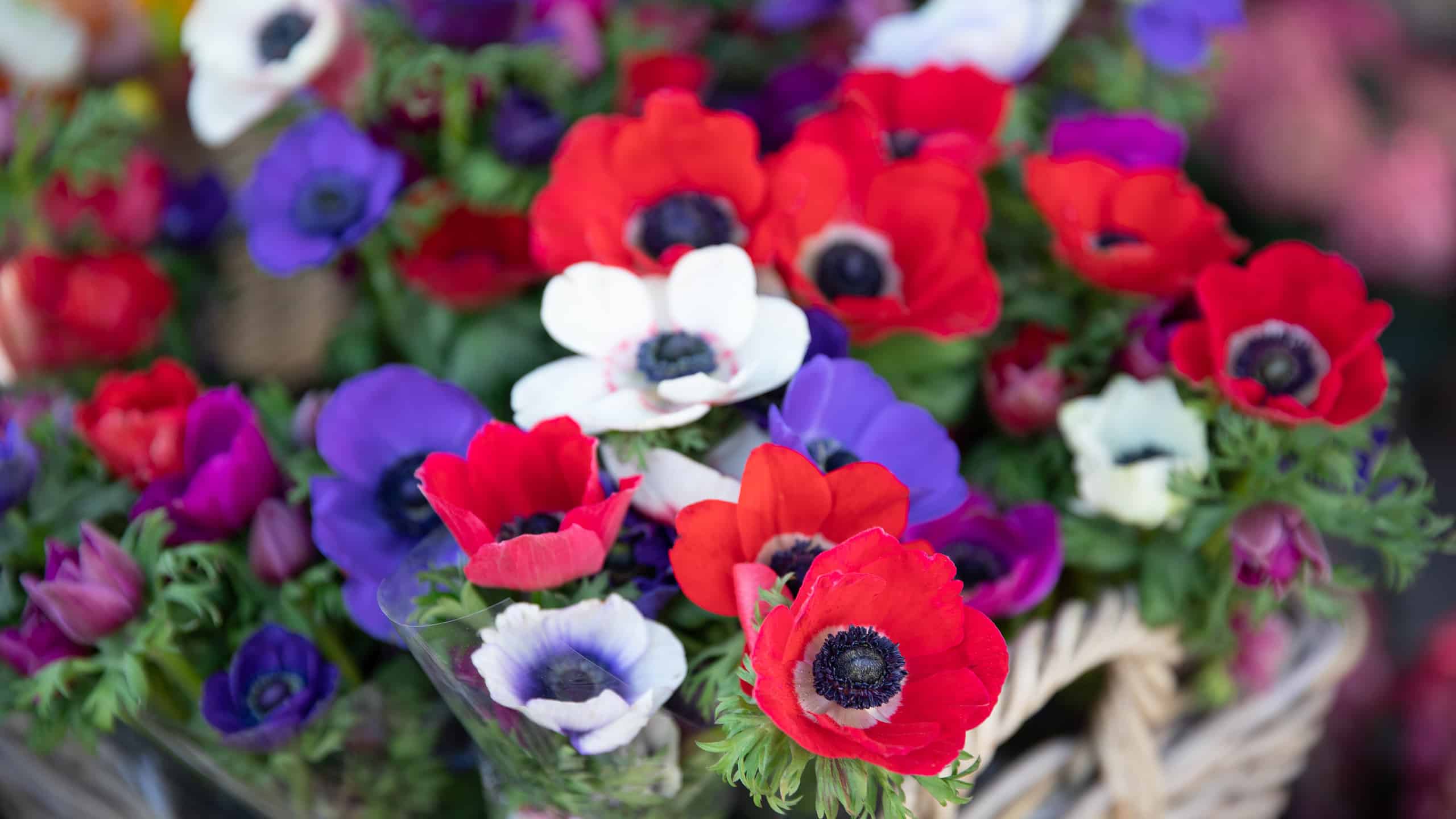Springtime bloomers with gorgeous shades of red, yellow, white, pink, and purple, anemones are a popular choice among traditional and container gardeners alike. The unique plants belong to the buttercup family, yet often resemble poppies, attract pollinators with their opening patterns and fragrances, and generally are easy to care for. Anemones are considered some of the easiest flowering bulbs to grow, when planted in the correct USDA Hardiness Zones.

Magenta Anemone St Brigid Double Flowering petals, just one attractive variety favored by gardeners.
©iStock.com/OlgaKorica
| Botanical name | Anemone |
| Popular varieties | Anemone ‘Hadspen Abundance’, Anemone ‘Wild Swan’, Anemone ‘September Charm’, Anemone ‘Splendens’, Canada Anemone, Tenpetal Anemone, Anemone De Caen, Anemone ‘Pocahontas’, Anemone ‘Whirlwind’, Anemone ‘Mr. Fokker’, Broadleaved Anemone, Yellow Wood Anemone, Balkan Anemone, Snowdrop Anemone, Anemone ‘Queen Charlotte’, Poppy Anemone ‘Bordeaux’, Blue Windflower, Candle Anemone, Japanese Anemone, Japanese Anemone ‘Montrose’, Round-Lobed Hepatica, Anemone ‘Prinz Heinrich’, Japanese Anemone ‘Honorine Jobert’, Poppy Anemone ‘Hollandia’, Japanese Anemone ‘Serenade’, Anemone ‘Robustissima’, Italian Anemone ‘Mistral Plus Bianco Centro Nero’, Anemone Hepatica, Japanese Anemone ‘Pamina’, Anemone ‘Leather and Lace’, Anemone ‘Cinderella’, Anemone ‘St Brigid Mix’, Anemone ‘Mona Lisa’ |
| Light needs | Full sun to partial shade, depending on the variety |
| Water needs | Well-watered after planting, maintained moisture throughout growing and blooming season, without sogginess |
| Soil needs | Compost-amended soil |
| USDA Hardiness Zones | 3 to 8, depending on variety |
| Beginner friendly? | Yes |
| Special care notes | Nothing of note. |
What Are Anemone Bulbs?
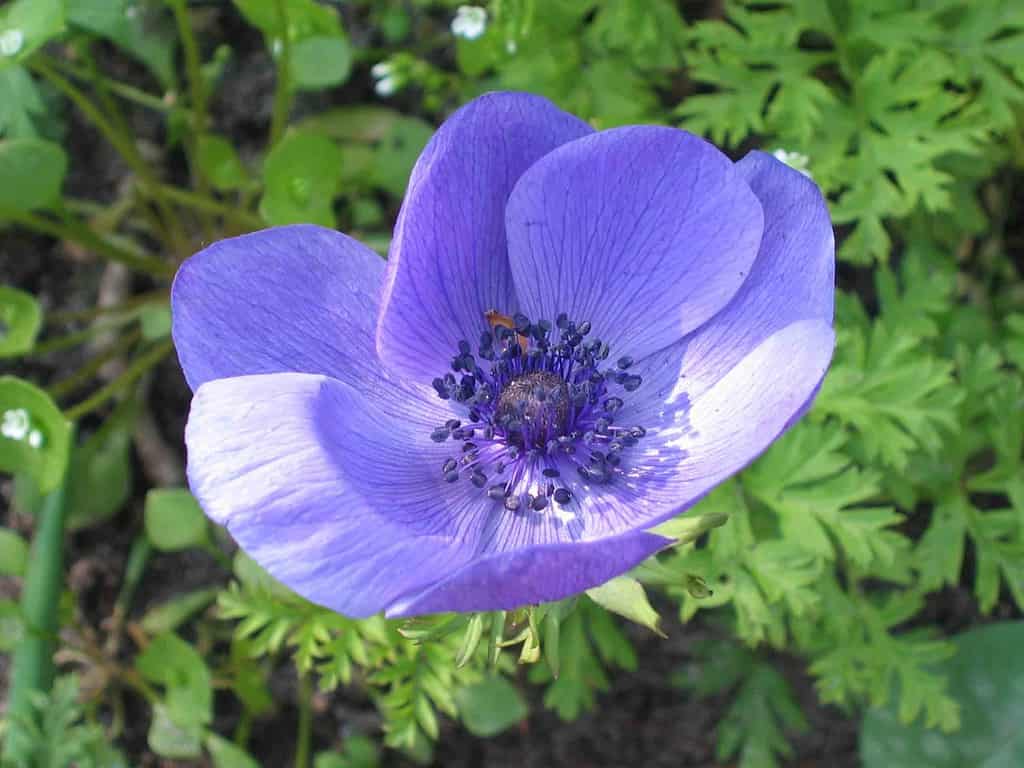
Anemone coronaria De Caen – a popular purple-blue option
Containing the entire life cycle of the plant, anemone bulbs belong to the windflower genus, or the Anemone genus officially. The plant belongs to the Ranunculaceae family, meaning it’s closely related to the buttercup. Thriving in temperate and subtropical regions of every continent, save Australia, New Zealand, and Antarctica, the flowering bulbs are a popular choice among gardeners for their lovely colors and attractive uses for pollinators.
When the correct variety is chosen for a given USDA Growing Zone, the anemone grows as a perennial, with basal leaves and long leaf-stems that may be upright or prostrate. Many of the flowers open during the day and close at night, and come in shades of red, white, yellow, pink, and purple (note: true blue shades are not available despite some varieties’ names).
What Is a Bulb?
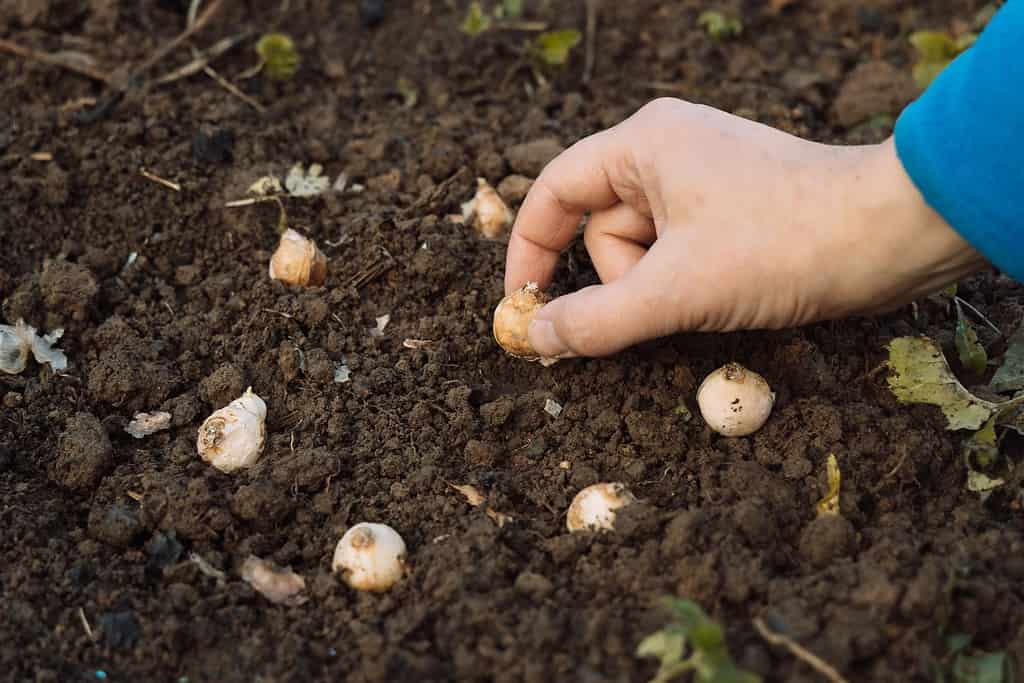
Bulbs come in many sizes.
©S.O.E/Shutterstock.com
Often used for bulbs, corms, tubers, tuberous roots, rhizomes, and fleshy roots, the term “bulb” actually refers exclusively to any plant that has an underground, fleshy storage structure in which it stores its full life cycle. This means that the bulb itself holds the nutrients the plant will need throughout its lifetime and rarely needs amendments in the form of fertilizers. Some bulb plants, like anemones, will still benefit from the use of certain plant foods, when applied in the correct season(s).
What Are Anemones Used For?
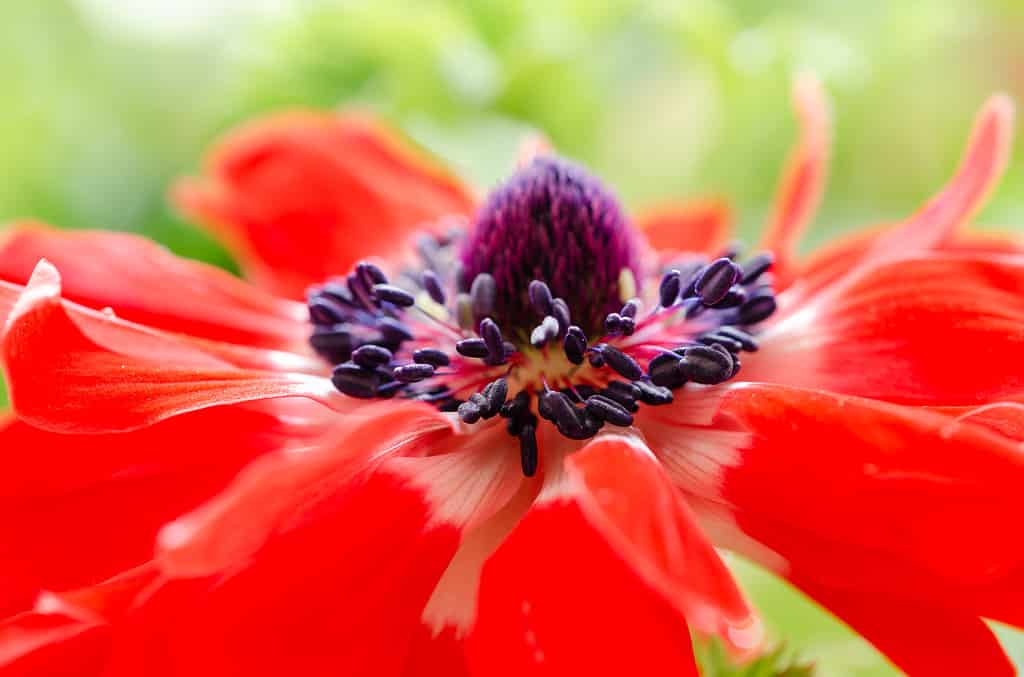
St. Brigid anemones provide vibrant spring blooms.
©iStock.com/nkeskin
Anemone flowers have many uses, though most familiar will be that of garden flower. Certain varieties are well suited to container gardens (tuberous varieties), while others are best planted directly in the ground. Herbal medicine has made use of these splendid plants, as well, with treatments for gout, nausea, and other digestive ailments most frequently benefited by the plants medicinal powers.
Never use an herbal treatment on your own without consulting a medical care provider first.
Varieties or Types of Anemones
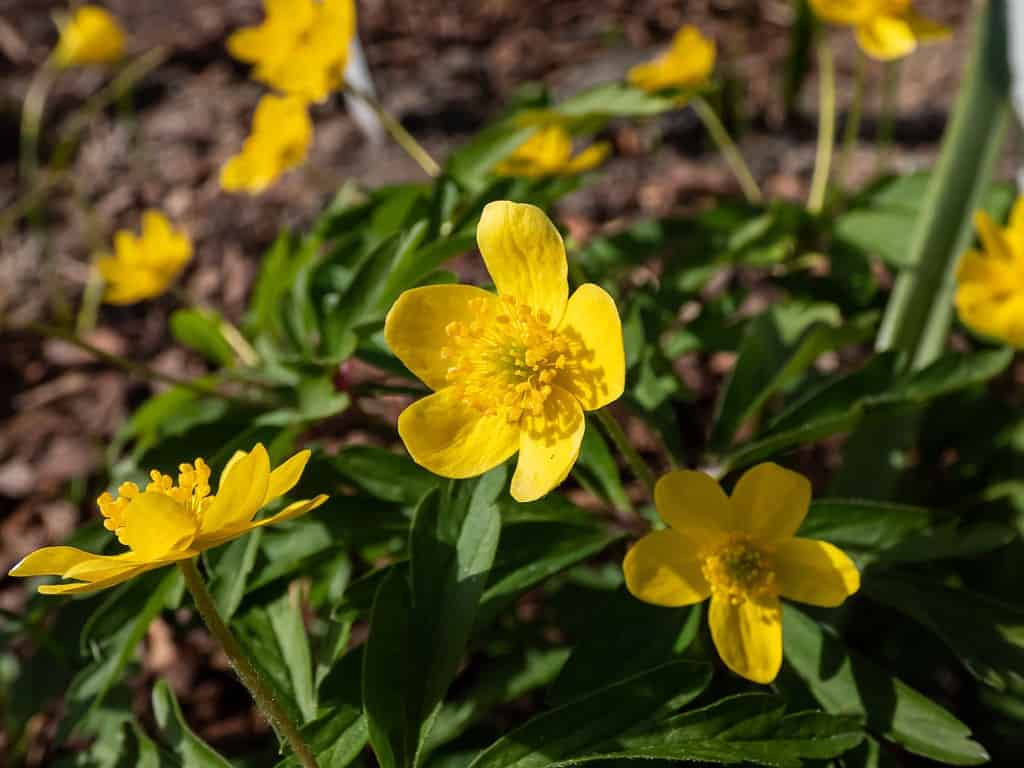
Yellow wood anemones are some of the most popular.
©Kristine Rad/Shutterstock.com
A wide range of anemones exist, with dozens as popular gardening choices, including the following species and varieties:
- Anemone ‘Hadspen Abundance’
- Anemone ‘Wild Swan’
- Anemone ‘September Charm’
- Anemone ‘Splendens’
- Canada Anemone
- Tenpetal Anemone
- Anemone De Caen
- Anemone ‘Pocahontas’
- Anemone ‘Whirlwind’
- Anemone ‘Mr. Fokker’
- Broadleaved Anemone
- Yellow Wood Anemone
- Balkan Anemone
- Snowdrop Anemone
- Anemone ‘Queen Charlotte’
- Poppy Anemone ‘Bordeaux’
- Blue Windflower
- Candle Anemone
- Japanese Anemone
- Japanese Anemone ‘Montrose’
- Round-Lobed Hepatica
- Anemone ‘Prinz Heinrich’
- Japanese Anemone ‘Honorine Jobert’
- Poppy Anemone ‘Hollandia’
- Japanese Anemone ‘Serenade’
- Anemone ‘Robustissima’
- Italian Anemone ‘Mistral Plus Bianco Centro Nero’
- Anemone Hepatica
- Japanese Anemone ‘Pamina’
- Anemone ‘Leather and Lace’
- Anemone ‘Cinderella’
- Anemone ‘St Brigid Mix’
- Anemone ‘Mona Lisa’
How to Care For Anemone Bulbs

Blue windflowers in blue, purple, white, and red
©Victoria Kurylo/Shutterstock.com
Generally speaking, anemones are easy plants to care for. However, a few specific care points will help ensure the health and long life of your anemone bulbs.
Light Requirements
In cooler USDA Growing Zones, anemones will thrive in full sun to light shade. In warmer environments, plant anemones in light to medium shade, unless the variety you’re planting specifies otherwise.
Water
Once you plant anemone bulbs, thoroughly soak the soil all around, then maintain a regular watering schedule during growing and blooming months, when the soil is slightly dry. Avoid over watering to prevent root rot – and skip watering in the dormant season.
Soil Conditions
Well-draining soil is the friend of nearly every kind of bulb plant; anemones are no exception. Improve the soil with some compost or organic matter when you plant for best results.
Fertilizer
Vegetative fertilizer can be just the thing your anemones need for maximum bloom power. Apply as directed on the bottle, once in early spring, once in late spring or early summer. Then, switch over to flowering fertilizer for summer application one to two times, depending on directions.
How to Propagate

Anemone coronaria, or ‘The Bride’, a stunning white double petal variety
©Photo_Traveller/Shutterstock.com
Propagation of most bulbs is pretty easy, including for anemones. In early spring or autumn, dig up the plants and, with a sharp knife or spade, divide the root ball into sections. Replant in a container or in the garden, cover with soil, and water thoroughly. That’s it! New anemones should crop up next year, assuming the bulbs you planted were healthy and are kept properly.
Thank you for reading! Have some feedback for us? Contact the AZ Animals editorial team.

